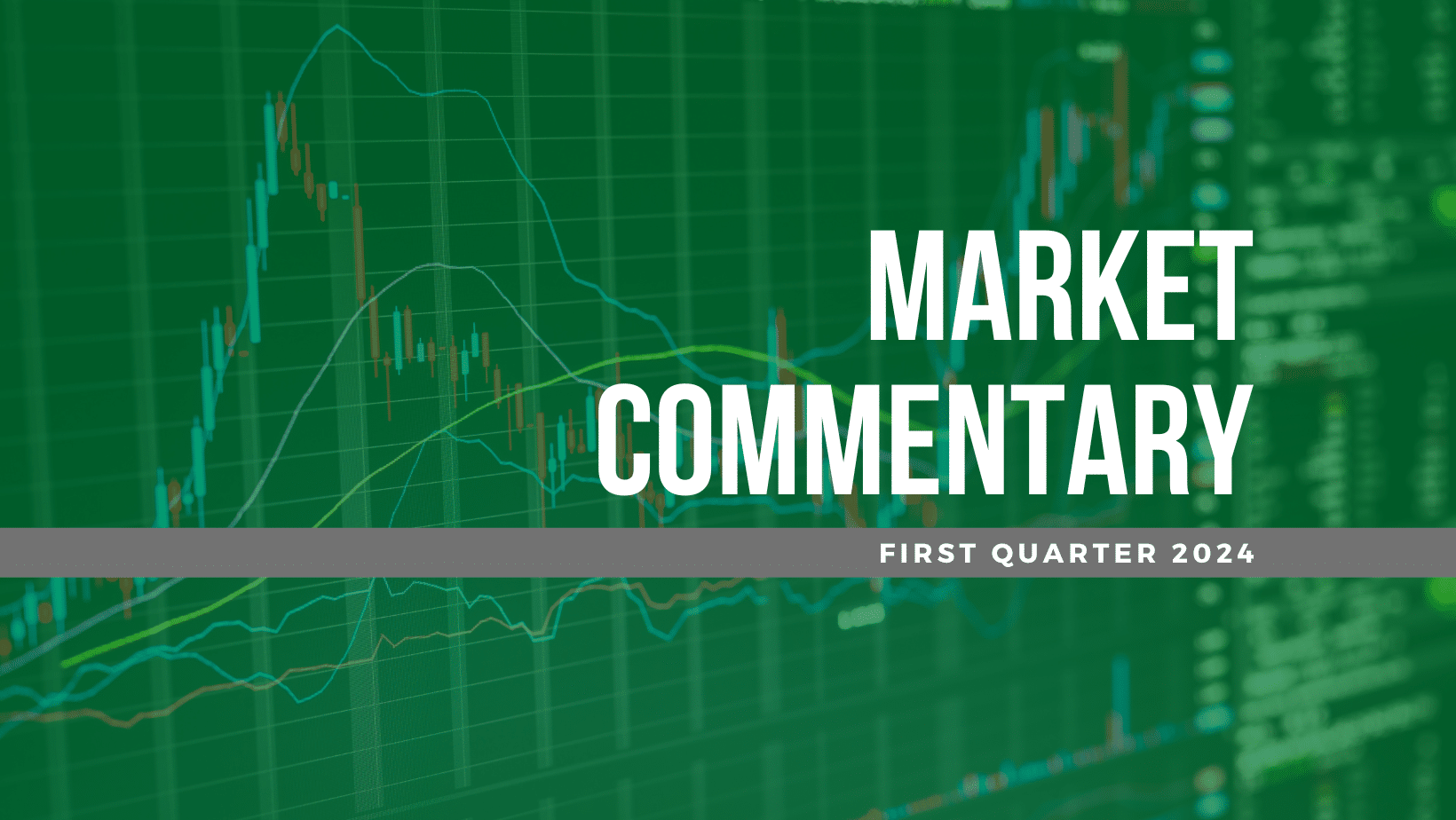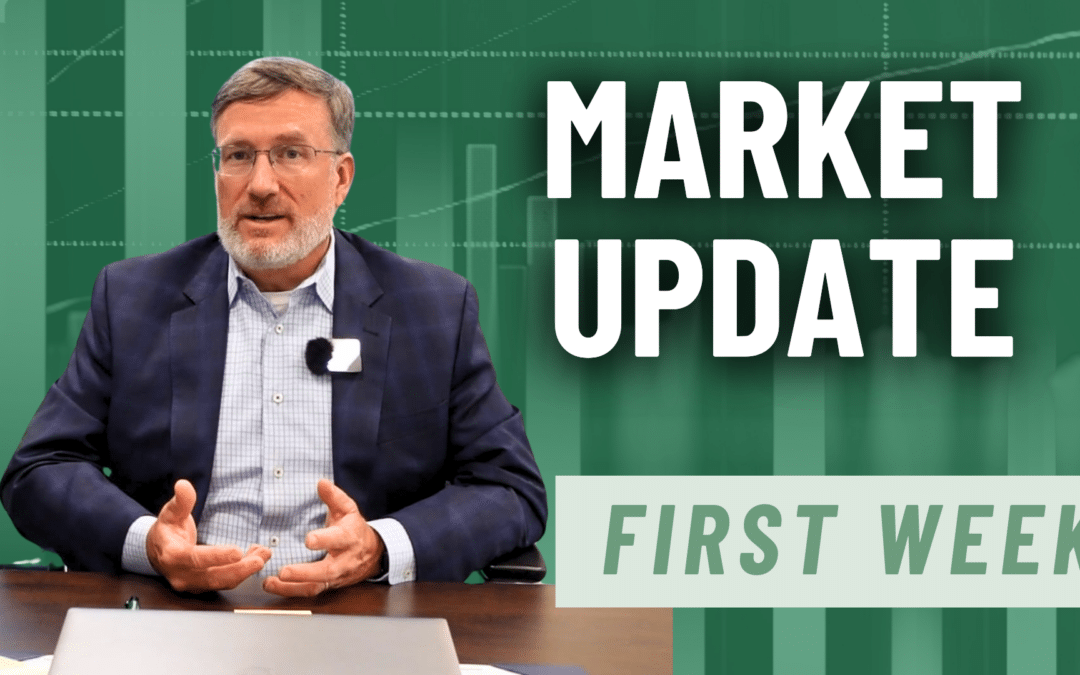Economic Overview
By Dr. Mark Pyles
The fact that financial markets tend to lead real-time data is well-known. In the never-ending race to buy before a run and sell before a drop, markets often start to “price in” scenarios far in advance of them actually happening. At the end of 2023, the Federal Reserve’s Open Market Committee (the “Fed”) had just pleasantly surprised the market by providing an expectation of three rate cuts for 2024 in their Summary of Economic Projections. This was the first solid evidence the market had received – although it was strongly suspected by that time – that one of the most aggressive interest rate hiking campaigns in history had come to an end.
Rate Hike Disappointment
We spoke in the last iteration of this commentary of why this brought such joyous relief. After spending much of 2023 waiting for the recession that did not materialize, coupled with economic data that held up better than most could have ever hoped, this was acknowledgment from the Fed that they felt the tightening had gone far enough.The market’s collective reaction was akin to stepping outdoors after a tornado to thankfully see that your house had been spared and all that you had to clean up were a few broken limbs lying around the lawn.
Alas, as markets are apt to do, they got a bit ahead of themselves. They saw the Fed’s three rate cuts and raised them three more. Thus far, that appears to have been overly optimistic and the market has been forced to adjust. As a brief, albeit overly simplistic, lesson in how the Fed views interest rates – the goal is to find the balance between controlling inflationary pressures without hampering economic growth or disrupting the labor market. For most of the last two years, the focus has been squarely on controlling the pricing pressures piece of the equation. As we exited 2023, evidence was mounting that the battle was being won. At the peak in summer 2022, headline Consumer Price Index (CPI) was over 9% year-over-year (YoY). From then until the end of 2023, that number had decreased to 3.4%.
However, both the January and February CPI numbers saw upside surprises on a month-over-month (MoM) basis, with headline prints of 0.3% and 0.4%, respectively. Core CPI, which strips out the volatile components of food and energy, also came in a bit hotter than expected and currently stands at 3.8% YoY after the February report. For perspective, the bigger picture view is still one where pricing pressures are generally alleviating. In fact, the Fed’s preferred measurement of inflation, Core PCE, currently stands at 2.8% YoY – which is not that far above the 2% target they have clearly indicated. However, the most recent months have shown that the last step down is likely to be bumpy and slower than desired.
Labor Market Ambiguity
Shifting gears, if you are a fan of ambiguity, the labor market data has something for just about everyone of late. We have spent much of the post-COVID period in the U.S. fighting a historically tight labor market, where there have been far more job openings than people looking for them, with very low unemployment rates and jobless claims, and consistently above expectation gains in employment numbers. Those statements remain true; however, like with most things in economic data, it is the trend that likely warrants the most attention. Nonfarm payroll figures continue to generally surprise to the upside, with all three data prints this quarter (for December, January, and February) exceeding expectations. In fact, there has only been one month (December of 2020) since the pandemic where payrolls have not grown. However, the trend is clearly slowing. Coming out of the COVID period, we averaged over 600k jobs added per month during 2021. This slowed considerably to just over 375k per month in 2022, and further still to just over 250k per month in 2023, which is also roughly the average of the first two months of this year.
Regardless of the trend, by nearly any historical comparison, these are robust numbers. The confusion comes when you look more broadly. The other notable labor market report that comes the first week of each month is from the household survey, which provides the data from which the unemployment rate is calculated. In sharp contrast to the nonfarm payroll figures, the household survey has indicated a reduction in the labor force in four of the last five months. This has resulted in the unemployment rate rising from a low of 3.4% last April to 3.9% as of the February release a few weeks ago. While still historically very low, this level of increase (0.5% or more) has often been a precursor of a recessionary environment.
To confuse the situation even further, jobless claims continue to remain low, at around 210k on a four-week rolling basis. Meanwhile, continuing claims have risen meaningfully from the lows of late last year but are still supportive by historical standards.
Inflation
That brings us to the third leg of the economic stool, growth. Inflation is a headwind to consumers, while strong labor markets are a clear tailwind. The expected harm to the labor market brought about by the aggressive financial constraint imposed on our society has been largely contained according to the aggregate of data. And while the Fed repeatedly stated during their hiking campaign that they expected it would necessarily require a period of “below-trend” economic growth to reign inflation to target, this has not yet occurred. We ended 2023 with Q4 real GDP growth of 3.4% quarter-over-quarter annualized. This was the sixth consecutive quarter of positive growth, averaging nearly 3% per quarter. Further, the current expectation for Q1 2024 growth stands at approximately 2.3%. Put simply, these are perfectly fine growth rates, particularly in comparison to the “impending doom” for 2023 that we discussed in last quarter’s commentary.
So, where does that leave us? Well, as it has for a couple quarters now, it leaves us with a feeling of uncomfortable optimism.
That oxymoronic statement is derived from inflation rates that are much more palatable now than a year or two ago (but are showing signs of stickiness in this last leg down), growth that is expected to slow (but remain positive) in the near-term future, and a labor market that is confusing (but that does not appear to be failing).
So, where does that leave us? Well, as it has for a couple quarters now, it leaves us with a feeling of uncomfortable optimism. That oxymoronic statement is derived from inflation rates that are much more palatable now than a year or two ago (but are showing signs of stickiness in this last leg down), growth that is expected to slow (but remain positive) in the near-term future, and a labor market that is confusing (but that does not appear to be failing).
On the negative side, the consumer faces headwinds of higher credit levels at much higher interest rates than in pre-COVID periods, prices that are still elevated, and dwindling savings as we continue to pay these higher prices (particularly on services and experiences). Some evidence of this is starting to show up, with retail sales figures in both January and February meaningfully surprising to the downside. We also have a contentious election year still largely ahead of us, geopolitical issues across the globe, and housing affordability that continues to deteriorate for much of the population.
To sum it all up, I will borrow a quote from a notable financial mind that I heard speak several months ago at a local event. He, in turn, borrowed a seminal quote from Charles Dickens and spun it to address the current state of the US economy.
“These are not the best of times. These are not the worst of times. These are … okay times.”
Upon reflection, when many were expecting the “worst” during 2023, this statement turned out to be correct. And now, when financial markets are perhaps pricing in the “best,” it likely also remains true.
The Stock Market
By Walter Todd
It’s hard to imagine, but March 31 marked the 25th anniversary of The Matrix movie release. The year was 1999 and I was about to finish graduate school and head to NYC to work on Wall Street. If you are not familiar with this movie, it was a mind-bender of a science-fiction film that seemed years ahead of its time. In the beginning, the main character, Neo, is given the choice of taking a red pill (to see reality outside the illusion of the world) or a blue pill (to remain seeing the world as he thought it existed). Watching the news flow and the markets these days, I sometimes feel like I am in the Matrix outlined in the movie, not exactly knowing what is real and what is a faqade created by machines. In this case, algorithms and computer models dictating the market’s reactions to every data point and utterance by the Federal Reserve. Alas, despite all the A.I. excitement out there, this is not a sci-fi thriller but the reality of today’s capital markets. The good news is, if you learn to read the matrix (as Neo did in the movie) you can take advantage when it overreacts or makes a mistake. Let us review what happened in the first quarter…”Mr. Anderson” (watch the movie for the reference.)
After a brief dip the first few days of 2024, the equity market (read the S&P 500) has largely not looked back during the first quarter. The S&P 500 Index closed up 10.6%, including dividends. This move continues to be mostly led by the largest names in the index, but we did see some broadening-out late in the quarter. For example, while the market cap weighted S&P 500 outperformed the equal-weight index by 2.6% in the quarter, the equal weight did outperform in March by 1.2%. Looking beyond the US large-cap space, small-cap stocks (as measured by the S&P 600) were positive for the period but rose just 2.5%. Outside the US, International stocks also participated in the move higher with Developed International Markets higher by 5.9% for the quarter (as measured by the EAFE Index) and Emerging Markets (EM) +2.4% for the quarter (measured by the MSCI Emerging Market Index). International stocks continue to be hampered by less Technology exposure vs the US and continued underperformance in China. Putting the US and International Markets together, the MSCI All¬ Country World Index (ACWI) finished up by +8.3% for the three-month period.
Similar to the last quarter of 2023, the first three months of the new year witnessed most sectors in the green, with 10 of 11 sectors positive for the period. Still, only 5 of 11 outperformed the overall market. The first quarter in 2024 did see some shakeup in sector leadership from the prior year. While Communication Services (+15.8%) and Technology (+12.7%) remained in the top three (at 1 & 3, respectively), Energy made a late move in the quarter to climb into the #2 spot (+13.7%) as oil rebounded on tighter supply and increased demand. Financials (+12.5%) and Industrials (+11.0%) rounded out the top five. The bottom four sectors for the quarter were mostly rate sensitive, including the only negative sector, Real Estate (-0.6%) along with Utilities (+4.6%) and Consumer Staples (+7.5%). Materials (+9.0%) and Healthcare (+8.9%) were sandwiched at six and seven in performance, with Materials making a strong move higher in the last month of the quarter.
Reflecting back on the past six months, the initial move higher by the equity market in response to falling rates in fourth quarter of 2023 makes sense. However, the recent continuation of this trajectory in the face of higher rates and falling rate cut expectations from the Fed seems counterintuitive to me. Perhaps you could square this circle with the assumption that the rate and Fed projection moves are the result of a firmer economic outlook. There is some evidence of this underneath the surface of the market when looking at the factors driving performance. The past month has seen a resurgence in the Value, Leverage and Dividends factors at the expense of Growth which would be consistent with this narrative. Still, we have yet to see this play out in small-cap stocks. Our equity strategies produced solid absolute returns for the quarter and witnessed an improving relative performance backdrop as the quarter progressed outside the narrowness of 2023 and January 2024. We believe this trend should continue as we look for relative value outside of the top of the market. Having said that, the move off the bottom in the overall market from October 2023 seems a bit stretched in the near term, perhaps leading to some volatility in the coming weeks and months.
The Bond Market
By John Wiseman
After a historic quarter of fixed income performance to end last year, 2024 had a more muted start. Bond yields moved slightly higher as economic data continues to surprise on the strong side and market expectations for a lower Federal Funds rate continue to get pushed further into the future. To be sure, the rate of inflation, as measured by the Federal Reserve’s preferred measure (Core Personal Consumption Expenditure), continues to come down. The key economic metric for yields at the moment is the labor market and the unemployment rate remains near historic lows. The Bloomberg Aggregate Index was slightly negative with a total return of -0.78% for the quarter. The yield on the 2-Year Treasury Note finished the quarter at 4.62%, 37 basis points (0.37%) higher than at the start of the quarter. The additional coupon income offset the move higher in rates to produce a total return of +0.21%. This was not the case for the 10-Year Treasury Note which was 32 basis points higher on the quarter to 4.20% and had a negative total return of -1.61%. We are opportunistically adding to duration given the move higher in rates.
The corporate bond sector continues to outperform its government peers. The spread of the Bloomberg Intermediate Corporate Index finished the quarter at 81 basis points (0.81%), the narrowest level in two years. The total return of this index was +0.26% for the quarter. This occurred even though investment-grade companies issued more bonds than ever before in a first quarter period. Issuance totaled more than $535 billion which eclipsed the previous record of $479 billion from the first quarter of 2020. Bonds of financial companies continue to be the best performers, exceeding utilities and industrials by 55 and 30 basis points, respectively, for the quarter. Additionally, lower-rated bonds continue to outperform investment-grade issues. Junk bonds outperformed higher-quality bonds by more than 85 basis points (0.85%). We expect issuance to remain robust which should eventually put pressure on spreads. We are relatively cautious within the corporate bond area and are reducing our exposure.
Municipal bond yields moved a little higher to start the year. The Bloomberg 5-Year Municipal Index had a negative total return of -0.37%. The ratio of the 5-Year Municipal to Treasury yield, a measure of relative value, moved up to 60%. Some state budgets have come under pressure as the sugar-high of federal support slows and costs escalate. The month of April is historically lighter for municipal bond issuance as tax revenue arrives. We expect the trend of higher issuance to continue as the calendar unfolds. While there is a healthy demand for tax-exempt bonds, this expanded supply will put pressure on their relative value. Focusing on high-quality general obligation and essential service entities with solid cash flows is of utmost importance.
Within our strategies, we remain shorter in duration overall though we continue to make efforts to lengthen the portfolios in the higher rate environment. This was beneficial to performance this quarter. Additionally, having more exposure to the credit sector helped our strategies for the quarterly period as narrower spreads offset the move higher in rates.
The information contained within has been obtained from sources believed to be reliable but cannot be guaranteed for accuracy. The opinions expressed are subject to change from time to time and do not constitute a recommendation to purchase or sell any security nor to engage in any particular investment strategy. Investment Advisory Services are offered through Greenwood Capital Associates, LLC, an SEC-registered investment advisor.











